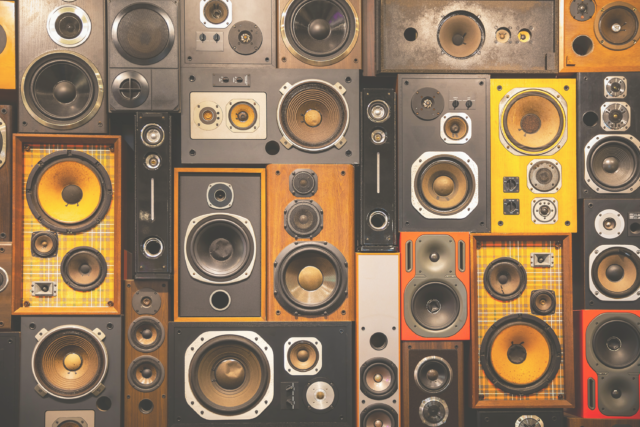
We’ve been hearing it for a while now: Visitors want dynamic, immersive experiences. How do you achieve this without breaking the bank on emerging technologies like VR and AR? Last week we wrote about using scent to create a layered sensory experience for visitors. Today, Museum 411 explores avenues for engaging and deepening connections with your visitors using sound.
Sound installations can be extremely immersive, but storytelling through sound is often underutilized or lower priority in exhibition design. Music, ambient sound, object-specific sound effects, and digital audio can all have a tremendous impact on visitor experience.
Think of it in the same way you understand sound to enhance the emotional resonance of movies. The Momentary currently features the traveling exhibition Dark Waters, in which photographer Kristine Potter reflects on “the Southern Gothic mythos found in the popular imagination of ‘murder ballads’ — traditional songs from the nineteenth and twentieth centuries that often end in death and despair.” The exhibition design is simple and minimalist: Spotlights illuminate black and white photographs, throwing the rest of the space into shadow.
Potter commissioned a few of her Nashville contemporaries to record these mournful folk songs, and they play (a bit loudly) as an integral part of the exhibition, not just background. It really works. The musical backdrop deepens the connection, creating a foreboding mood that allows the experience to linger, even after you’ve left the museum.
Sound can have particular impact in historical settings. Cutty Sark, the fastest sailing ship of its time, part of Royal Museums Greenwich, now gives visitors an immersive digital audio experience on board:
Cutty Sark Soundscape transports you 150 years back in time to hear what the ship might have sounded like while sailing across the world in a variety of wind conditions.
The sounds have been made to be as accurate and realistic as possible, ranging from being outside on the Main Deck in near-gale conditions to tea chests being loaded in Lower Hold. The experience is peppered with localised sound effects, ranging from various animal noises to the ringing of a ship’s bell.
Accompanying these ambient sounds, the soundscape features specially composed music…
Explore the details of the soundscape creation and how it works here: Cutty Sark Soundscape.
The Natural History Museum in London currently offers a first-of-its-kind sound-based art and science collab The River, featuring immersive, underwater audio from the Thames. Visitors are invited to sit on beanbags and benches and let the sound wash over them:
From the ambient crackling of gas bubbles at the source by Kemble, the bustling industry of Central London, and the sprawling estuary into the North Sea, listeners will experience a huge range of sounds created and heard by aquatic species. These sound environments evolved over millions of years into a finely tuned orchestra of underwater life but are increasingly disrupted by the imposing noise of human activity, the impact of which we are yet to fully understand. (Source: NHM)
Accessibility
With a constant and necessary focus on inclusive experiences at museums, any mention of sound should prompt a question of accessibility.
Captioning and individual audio delivery options that offer volume control are the most obvious solutions. In a Q&A with AAM, experiential sound designers also delve into sign language, haptics, and working with collaborators who are deaf: Transforming Museums With Immersive Sound.
How to integrate sound in exhibitions
A recurring fear with curators seems to be that sound could be overwhelming or distract the audience from the other exhibited media (objects, images, texts). I think that ruling out sound means giving up on an entire layer of perception that can add a lot to an exhibition, if adequately designed and kept in balance with the other content elements and the interior design. (Source: Q&A with David Kamp: Museum Sound Design)
When it comes to implementing sound, you have quite a few options:
- Ambient soundscapes
- Interactive sound installations
- Spatial audio
- Object-specific sound effects
- Narration and audio guides
- Dynamic soundtracks
- Personalized sound experiences
- Environmental sound design
Read more on what each of these entail plus practical examples of their uses in museums here: The Crucial Role of Sound Design in Museums (by Dr. Alexander Lavrov). This excellent resource also discusses personnel requirements and curator involvement in the creation of sound-based visitor experiences.
12/24 update: There’s a new (paywalled) paper in Curator: The Museum Journal on Communicating Through Sound in Museums: A Genre-Based Framework that includes real-world examples from more than 100 exhibitions that showcase sound in creative ways.




